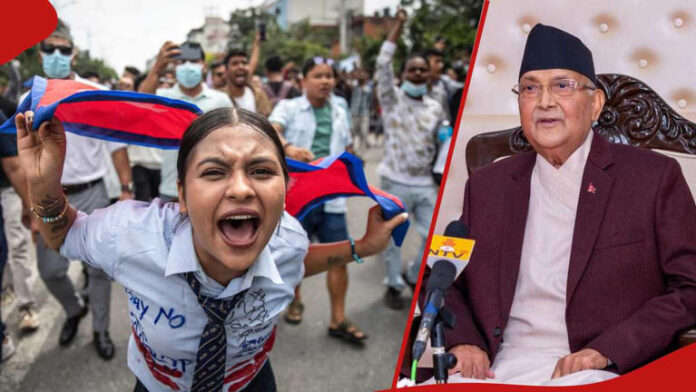Parliament Building Set Ablaze After Days of Unrest
Kathmandu descended into chaos late Tuesday as Nepal’s parliament building was set on fire by furious protesters following the dramatic resignation of Prime Minister KP Sharma Oli. The blaze erupted in the heart of the capital as demonstrators smashed windows, hurled stones, and lit bonfires around the complex while chanting anti-corruption slogans. Thick smoke could be seen rising over Kathmandu’s skyline as security forces struggled to contain the violence.
BBC correspondent Charlotte Scarr, reporting from the scene, described young protesters “dancing and chanting around the flames,” with the parliament building heavily damaged inside and out.
The prime minister’s resignation, announced just hours before the fire, followed days of intensifying demonstrations led largely by students and young activists disillusioned with political elites and rampant corruption.
Why the Protests Erupted
)
The unrest was sparked last week when the government abruptly banned 26 social media platforms—including Facebook, Instagram, and WhatsApp—claiming the companies had failed to register under new regulations. Critics immediately accused Oli’s administration of attempting to silence dissent and derail an online anti-corruption campaign gaining traction among the country’s youth.
The ban was reversed on Monday night, but by then the protests had already transformed into a broader movement. At the heart of the anger lies what demonstrators call a culture of “nepo kids”—the perception that children of politicians and wealthy elites unfairly dominate opportunities in government and business. For many young Nepalis, the ban became the tipping point after years of frustration over limited jobs, corruption, and political stagnation.
Who Is Protesting?
Unlike previous political uprisings in Nepal, this wave is overwhelmingly led by Generation Z. University and college students have been at the forefront, mobilizing in cities across the country including Kathmandu, Pokhara, and Itahari.
Placards, graffiti, and chants highlight the movement’s digital-savvy character, with hashtags and slogans spreading rapidly online before the ban. Even after the platforms were restored, activists continued to use them to rally supporters and share footage of the protests.
Observers say this is the largest youth-led uprising Nepal has seen since the end of the monarchy in 2008.
Demands of the Protesters
The protesters’ demands are clear:
-
An end to government corruption and nepotism.
-
Greater transparency and accountability from elected leaders.
-
Protection of free speech and digital rights.
While the first demand—the lifting of the social media ban—has already been met, the resignation of Prime Minister Oli has only emboldened protesters to push for systemic reforms.
Violence and Rising Death Toll

The demonstrations have taken a deadly turn. Clashes between police and protesters in Kathmandu and other cities have left at least 22 people dead since the unrest began, with three fatalities confirmed on Tuesday alone.
Hospitals across the capital reported a surge of casualties. The Civil Service Hospital admitted more than 200 people during Tuesday’s unrest, though most were later discharged. The National Trauma Centre confirmed treating nearly 40 severely injured protesters.
Police have used batons, rubber bullets, and tear gas to disperse crowds, while demonstrators have targeted government buildings and the homes of senior politicians.
Nepali Army and President Call for Calm
The Nepali Army issued a statement urging protesters—most of them young people—to exercise restraint. It pledged to “safeguard the interests of Nepal and the Nepali people” while closely monitoring the escalating crisis.
President Ram Chandra Poudel also appealed for dialogue, calling on demonstrators to seek peaceful solutions. “The voices of the youth must be heard, but violence cannot shape the future of Nepal,” he said in a televised address.
The army is expected to deliver its own nationwide address later tonight, fueling speculation over whether military intervention might be considered if the civilian government fails to restore order.
What Happens Next?
With Oli stepping down, Nepal enters a period of political uncertainty. No clear successor has yet emerged, and parties are scrambling to negotiate a new coalition. Analysts warn that without swift leadership, the power vacuum could deepen instability.
South Asia regional observers note that restoring calm will require more than just replacing the prime minister. The Gen Z-led protests reflect a generational demand for systemic change, not simply a change in faces at the top.
A Turning Point for Nepal’s Youth
For Nepal’s younger generation, the uprising marks a historic moment. Many demonstrators see themselves not only as protesters but as the future of the country—one demanding fairness, transparency, and opportunities free from political favoritism.
Whether Nepal’s leaders can respond meaningfully to these demands remains uncertain. For now, Kathmandu is engulfed in smoke, anger, and uncertainty, as the parliament building smolders—a symbol of a political system under siege by its youngest citizens.
Sources: BBC

